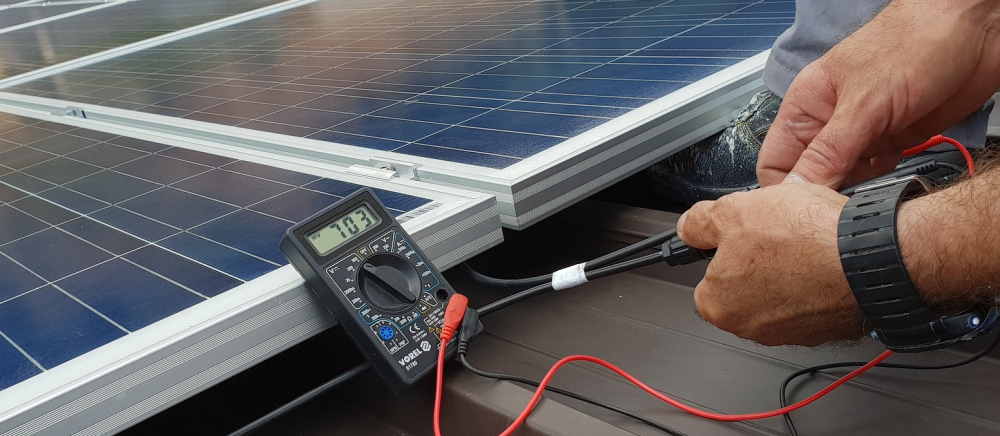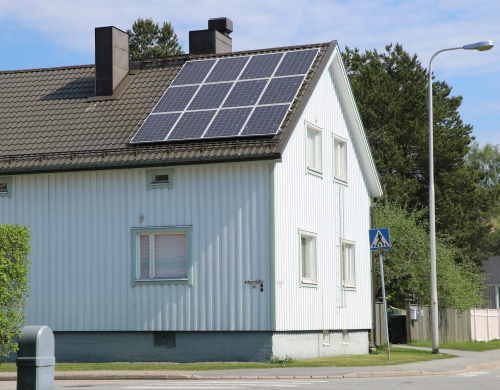Before we start, here are a few words about solar panels. Later on, you can read more about the best solar panels for a tiny house.
A solar panel is a device that converts sunlight into electricity. Solar panels are made up of photovoltaic (PV) cells, which are typically made of silicon or other materials that can absorb photons of light and convert them into electrical energy.
When sunlight hits a solar panel, the PV cells in the panel absorb the photons and release electrons, which flow through a circuit in the panel and generate electrical power. This power can be used to power devices or stored in batteries for later use.
Solar panels are a renewable and sustainable source of energy. They do not produce any greenhouse gases or other pollutants, making them an environmentally friendly option for generating electricity. Additionally, solar panels can be installed on rooftops, in fields, or in other areas with access to sunlight, making them a flexible and versatile option for powering homes, businesses, and other applications.
One of the key advantages of solar panels is that they can help reduce energy costs over time. While the upfront cost of installing solar panels can be high, the savings on energy bills over the life of the panels can often make up for the initial investment. Additionally, many governments and utilities offer incentives and rebates for installing solar panels, which can further reduce the cost of installation.
Overall, solar panels are an important technology for generating clean and sustainable energy. As the cost of solar technology continues to decline and the efficiency of solar panels continues to improve, they are becoming an increasingly viable option for powering a wide range of applications, from homes and businesses to vehicles and even entire communities.
What to look for when choosing solar panels for a tiny home?
The best solar panel for a tiny home depends on several factors, including the size of the home, the energy requirements of the occupants, and the available sunlight in the location where the home is situated. However, here are some general factors to consider when choosing a solar panel for a tiny home:
- Efficiency: Look for solar panels that have high efficiency ratings, which means they can produce more electricity from the same amount of sunlight. This can help maximize the amount of energy generated from a smaller panel.
- Size: Consider the physical dimensions of the solar panel to ensure it can fit on the roof or other location where it will be installed. For a tiny home, a smaller panel may be more appropriate than a larger one.
- Power output: Determine the amount of electricity the occupants will need and choose a solar panel that can meet those needs. It is important to strike a balance between power output and size/cost.
- Durability: Choose a solar panel that is durable and can withstand harsh weather conditions, such as wind, rain, and snow.
- Cost: Determine your budget and look for solar panels that provide good value for money, balancing efficiency, size, power output, and durability.
Some popular options for solar panels for tiny homes include the SunPower E20 series, LG Neon 2, and Panasonic HIT series. However, it is always best to consult with a solar energy professional who can help determine the best solar panel for your specific needs and location.
How many kilowatts for tiny house?

The amount of kilowatts required for a tiny house depends on several factors, including the size of the house, the energy requirements of the occupants, and the type of appliances and equipment used in the house. However, as a general guideline, a typical tiny house may require anywhere from 1 to 5 kilowatts of power, depending on the level of energy efficiency and the amount of electricity consumed by the occupants.

To determine the energy requirements of your tiny house, you can start by calculating the estimated daily energy consumption of your appliances and electronics. This can be done by looking at the wattage ratings of each device and estimating the number of hours per day they are used. Once you have an estimated daily energy consumption, you can determine the total energy needs of your tiny house and choose an appropriate solar panel system to meet those needs.
It is important to note that the size of the solar panel system required will also depend on the amount of sunlight available in your location and the efficiency of the solar panels used. A professional solar energy installer can help you determine the appropriate size of the solar panel system for your tiny house based on your energy requirements and location.
What battery type should be used?
The type of battery used in a tiny house solar panel system depends on several factors, including the amount of energy storage required, the available space for the batteries, and the budget. Here are some common types of batteries used in solar panel systems:
- Lead-Acid Batteries: These are the most common type of battery used in solar panel systems. They are relatively inexpensive, easy to maintain, and have a long lifespan. However, they are heavy and have a lower energy density compared to other battery types.
- Lithium-Ion Batteries: These batteries are becoming increasingly popular in solar panel systems due to their high energy density, lightweight, and longer lifespan compared to lead-acid batteries. They also require less maintenance and can be charged and discharged more efficiently. However, they are more expensive than lead-acid batteries.
- Nickel-Iron Batteries: These batteries are a less common option but offer a longer lifespan and higher energy density than lead-acid batteries. They are also more durable and can handle a wider range of temperatures. However, they are more expensive than lead-acid batteries.
Ultimately, the type of battery used in a tiny house solar panel system will depend on the specific needs and budget of the occupants. It is recommended to consult with a professional solar energy installer to determine the best battery type and capacity for your system.
Conclusion
In conclusion, solar panels can be an excellent source of renewable and sustainable energy for a tiny home. The best solar panel for a tiny home depends on factors such as efficiency, size, power output, durability, and cost. Similarly, the type of battery used in a tiny home solar panel system depends on factors such as energy storage, available space, and budget.
Consultation with a professional solar energy installer can help determine the best solar panel and battery options for your specific needs and location. With the right solar panel and battery system in place, a tiny home can enjoy clean and reliable energy while reducing its carbon footprint and energy costs.
